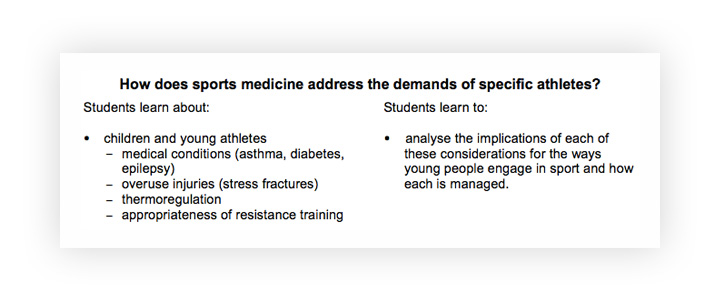5 steps to smashing a PDHPE exam

PDHPE might be a heavyweight champion when it comes to content but the best news is that it's one of those subjects anyone can do really well in. You just need the right approach to learning the content and to make sure that you’re always thinking about the endgame in that exam. Sound good to you? Well, here are the 5 steps to smashing your PDHPE exam out of the park.
Step 1. Memorise key words and phrases from the syllabus
Yeah yeah, we always bang on about the syllabus but when it comes to PDHPE, this cheeky little document is basically going to let you in on all the potential exam questions and give you the equipment to answer them. See, PDHPE is a seriously syllabus dependent subject which means that learning the syllabus back to front will pretty much prepare you for any question that could come up in an exam. If we take a look at the syllabus, we see two columns. The first - Students learn about - basically gives you the content you need to know and is great for structuring notes. BUT that second column - Students learn to - is basically showing you how the HSC will ask you to apply that content.

“Describe the advantages and disadvantages of Medicare and Private Health Insurance” could be an exact exam question so if you haven’t already, get to you know your syllabus nice and closely. That way, there’ll be less surprises in the exam.
Bonus tip: the more you can throw the relevant syllabus keywords and phrases into your answers, the more you’ll be set up for a winning answer 🏆 .
Step 2. Always give specific, scenario style examples
It’s pretty obvious that you should be adding in examples to your exam answers but when it comes to PDHPE, there’s really a certain type of example you need to be gunning for. Let’s work with an actual question here to make things as clear as possible. Take part (b) from the 2011 HSC PDHPE paper.

Because you’re going to know your syllabus so amazingly well, reading ‘climatic conditions’ in a Sports Medicine question should make you think of the environmental considerations and one of those dot points is guidelines for fluid intake. This would make up one of your points and instead of using an example like ‘someone running on a hot day might drink more water’, you’re better off making a little scenario so you can give more detail. Try ‘a man running a half marathon on a hot/humid day would drink at least 200ml of fluid for every 15 minutes of running to stay hydrated’. Then you could explain that staying hydrated has a significant effect on temperature regulation by assisting evaporation.
The whole point of that is basically when it comes to examples in PDHPE, keep them as specific as possible 👍 .
Step 3. Acronyms and mnemonics are the new love of your life
It might sound like an exaggeration but seriously, acronyms and mnemonics give you the kind of support that none of your crushes ever could. PDHPE is definitely content heavy and there are a lot of lists that you’re going to need to remember whether it's a list of different principles, relevant factors, types of training, steps in a process and so on basically forever 🤷♀️ . Yay. This means that making acronyms and other kinds of mnemonics (memory tricks) is the best way to learn the content so it’s really easy to remember in your exam.
So for example, here is the content from the Stage 6 PDHPE syllabus that gives you four points to remember about children and young atheletes under the sports medicine option.

Rearrange that content:
A - Appropriateness of resistance training
T - Thermoregulation
O - Overuse injuries
M - Medical conditions
And you have A.T.O.M which is super easy to remember because atoms are small and children are also small… Mind blown.
For real though, little acronyms and tricks like this will make it so easy when you come up against a question like: How does sports medicine address the medical conditions of children and young athletes? (5 marks), you can just remember A.T.O.M. and that will basically write your paragraph for you.
Feel free to write down the acronyms on your working paper at the beginning of the exam before you get stuck in and distracted by other questions so you can always hit them up.
Step 4. Be super careful with the multiple choice section
Not many subjects have as many multiple choice questions as PDHPE - like, we’re talking 20 out of the total 100 marks of the paper - so you’ve really got to be on the ball here. Firstly, it’s going to help if you know all the content, that’s the first step and probably the most obvious one (that’s where our new love, acronyms, come in 😍 ). But PDHPE exams like to get a bit sneaky and have some trick options that look close enough but there is a better answer.
Check out question 2 from the 2016 paper:

All of those options look like they could be a pretty good reason for causing fatigue in a runner and options B, C and D are all content on causing fatigue from the dot point on energy systems. Tricky, right? You need to pay attention to the fact it’s a 100m sprint and then think back to the content you learnt on the different energy systems. Because it’s a quick burst of energy, we’d be talking about the Alactacid system which uses phosphocreatine as fuel. Option D.
The secret is to work through them carefully and start by ruling out the obviously wrong answers. We’ve got a few more multiple choice tips and tricks over here if you want to read more.
Step 5. Learn the common PDHPE question keywords and how to tackle them
Oh look… another one of our fave pieces of advice but with a bit of a twist this time. Yeah, you do need to address the question keyword in every subject but this is seriously so important when it comes to PDHPE and there are a few keywords that crop up more than others. Luckily, our PDHPE experts pulled these out for you, ordered them based on how many marks those questions are usually worth and given you a few phrases to keep up your sleeve.

(This was pulled from a video on how to answer PDHPE questions. If you want to check it out search for the video under Year 12 PDHPE here.)
Learn these popular verbs and make sure the language you choose in your answer is really going to hit the nail on the head 🎯.
Remember
PDHPE is actually great because it’s one of those subjects that anyone can do well in (yes, including you). You just need the right approach. Be smart about learning the content (always be thinking about how you can remember it and use it in an exam), keep a close eye on the syllabus and learn how to answer PDHPE questions. Keep this all in mind for your exam and you’ll smash it out of the park. 🏌️🏌️🏌️
References
What's Atomi?
Engaging, curriculum-specific videos and interactive lessons backed by research, so you can study smarter, not harder.
With tens of thousands of practice questions and custom revision sessions, you won’t just think you’re ready. You’ll know you are!
Study skills strategies and tips, AI-powered revision recommendations and progress insights help you stay on track.
What's Atomi?
Short, curriculum-specific videos and interactive content that’s easy to understand and backed by the latest research.
Active recall quizzes, topic-based tests and exam practice enable students to build their skills and get immediate feedback.
Our AI understands each student's progress and makes intelligent recommendations based on their strengths and weaknesses.




